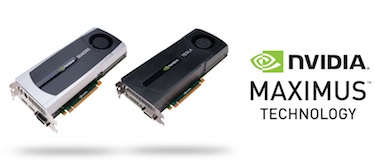Check it Out: Get the Lowdown on Dell Precision Workstations with NVIDIA Maximus
December 4, 2001
By Anthony J. Lockwood
 You know the story: You queue up an important structural analysis or rendering job, and it’s honking huge. You know it’s going to take forever because your workstation is just not set up for such things. So what do you do? As one engineer put it recently, “I have been known to do something on the machine, then go off to eat dinner, then come back, hoping it was finished.”
You know the story: You queue up an important structural analysis or rendering job, and it’s honking huge. You know it’s going to take forever because your workstation is just not set up for such things. So what do you do? As one engineer put it recently, “I have been known to do something on the machine, then go off to eat dinner, then come back, hoping it was finished.”
For many engineers this is an accepted, albeit maddening, condition of your work. Truth be told, just because this is the way it’s always been does not make it right. You’ve a job to do, and rendering your computer fitful or unusable for any length of time squanders your time and money” your company’s too.
Back in the late fall, NVIDIA announced its Maximus technology. The 5-second pitch is that Maximus enables a single workstation to handle interactive graphics and compute-intensive simulation or rendering simultaneously. How it does what it does has three main ingredients.
First, NVIDIA Maximus technology unites the company’s professional-level 3D graphics capabilities of its Quadro GPUs (graphics processing units) with its Tesla C2075 companion processor. The NVIDIA Tesla C2075, which has 448 application-acceleration cores per board, is engineered for high-performance computing, and is spot on for CAE or photorealistic rendering applications” that tap the computational power of GPUs.
Second, it’s the applications themselves. Developers such as Adobe, Autodesk, Dassault, PTC, and the MathWorks have certified Maximus support. This means that, transparently, compute-intensive work gets assigned to run on the NVIDIA Tesla C2075 automatically. And that means the NVIDIA Quadro GPU is free to handle advanced visualization and interactive graphics while some of your workstation’s CPU cores are released to run the rest of the system operations.
Your workstation is the final ingredient. In a nutshell, you need to have the right workstation for engineering work. And I mean vendor-certified for NVIDIA Maximus. Dell, for example, makes the Maximus-certified Dell Precision T5500.
What this all means to you is that you can run, say, an ANSYS or Abaqus structural dynamics analysis or photorealistically render a model in 3ds Max or Bunkspeed in the background and still be designing with Inventor or SolidWorks at full interactive performance. Multitasking productively. What a concept. It also means that you lose a great excuse to wander off and pester your coworkers.
You can get the lowdown on Dell Precision Workstations with NVIDIA’s Maximus technology from this link. There are some interesting charts on performance increases you could reap. But make sure to watch the video on the right-hand side. Once you see it (it’s about 5 minutes), you’ll know that you don’t have to accept unexceptional performance.
Get the Lowdown on Dell Precision Workstations with NVIDIA Maximus.
Subscribe to our FREE magazine, FREE email newsletters or both!
About the Author
Anthony J. Lockwood is Digital Engineering’s founding editor. He is now retired. Contact him via [email protected].
Follow DE





